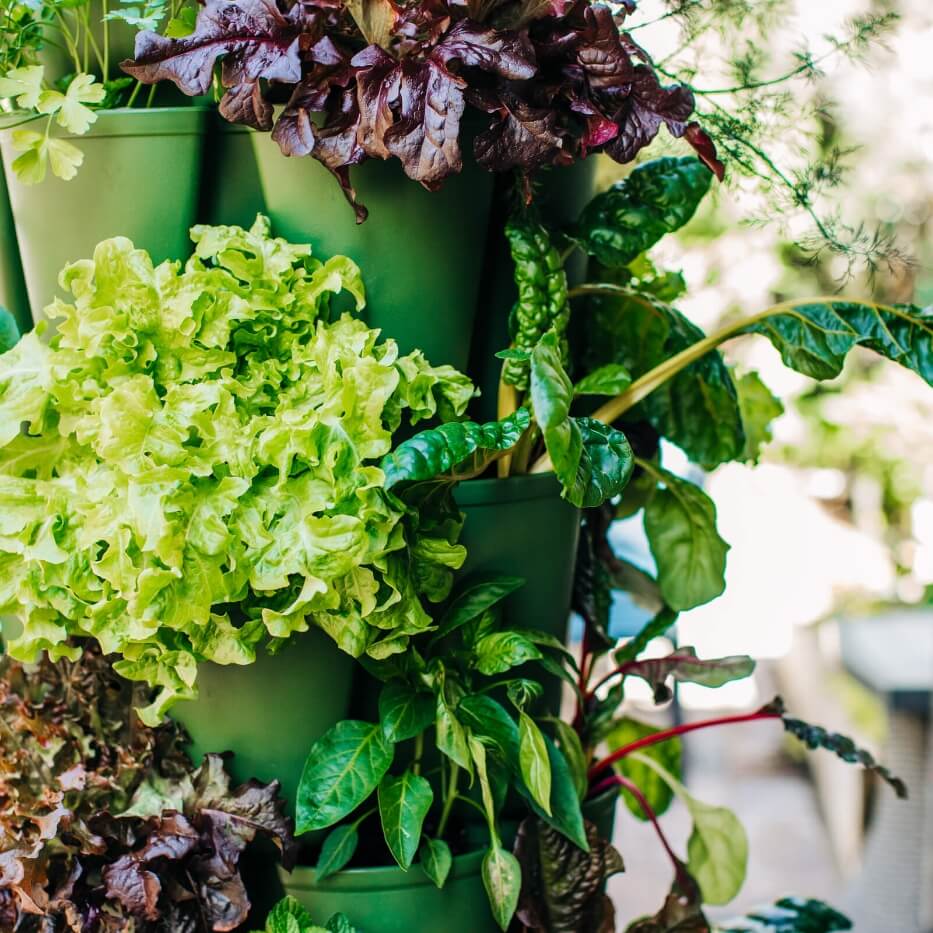We’ve all had it happen to us: you open a beautiful package of seeds and in eager excitement, plant them all. You tend them, watch them germinate, and before you know it, they’re fully mature. All of the plants are ready for harvest…at the same time. And you have way more lettuce, spinach, or carrots than you can eat (or preserve) at once. Your kitchen is overwhelmed with one crop and you scramble to preserve or share your bounty.
If you would rather enjoy fresh produce coming in at a manageable pace, try succession planting. It is a method loved and used by many experienced gardeners, and we’ll show you how easy it is to do in a GreenStalk Vertical Garden!
What is succession planting?
Succession planting simply means planting your garden in continuous rounds. For example: direct sow a couple of pockets of lettuce, then a week or two later, sow a couple more pockets of lettuce, and continue doing that for as long as you’d like… or as long as the growing season allows. Continual planting = continual harvest! When spacing apart your plantings, you should consider how long your different plant varieties need from seed to harvest, and how often you want to be harvesting.

Succession planting allows you to enjoy continual harvests from your GreenStalk Vertical Garden.
What to succession plant?
This method works best with smaller plants that give a one-time harvest or a smaller secondary harvest. Leafy greens like lettuce, spinach, kale, and even cabbage are great candidates for succession planting, especially if you enjoy harvesting a full head. Root vegetables like carrots, beets, and parsnips are wonderful for growing this way so you can have a steady harvest of fresh vegetables. Broccoli produces a large head and after that first harvest, the plant will produce smaller side shoots. However, these can take a while. If you succession plant your broccoli, you can enjoy nice big first-harvest heads of broccoli over a longer period.
Herbs sometimes need a little time to grow back after snipping them down. If you succession plant them, you can cut the first one back for a meal but have others ready to go on a different day. By the time the first one is trying to go to seed, you’ll still have some that are just getting started.
Some other plants to consider succession planting are cauliflower, beets, beans, and peas.

The GreenStalk Journal is helpful for planning your garden.
How to plan
It's a good idea to plant in the same increments of time. For instance, plant every seven days or every fourteen days. This will help you to monitor your succession planting more carefully. We also recommend planting your GreenStalk with some organization or pattern in mind—plant one tier one week, the next tier the next week, and so forth. Or plant in a vertical row of pockets and continue around your GreenStalk each week. This part should be fun. Do it the way you like it!
Keeping track of what you have planted and when to plant next can be the tricky part. But we have got you covered! Click here for a free printable PDF of our GreenStalk plant planner. But we highly recommend our GreenStalk Garden Journal which has several pages for record-keeping, unmarked calendar pages, pockets, and everything is nicely tabbed! Or if you’d like to be able to print as many planning pages as you like, we have a Digital Download of the Garden Journal.
It’s also beneficial to mark your crops and planting dates directly on your pockets. Try our stainless steel Pack of 25 Plant Markers or our Blank Plant Marker Stickers.

Consider replacing cold-season plants with bush beans.
Seasonal succession
One last thought on succession planting: this method can also be used to switch out cold-season plants for warm-season ones, and vice versa. For example, after you harvest your first planting of spring radishes, trade out those pockets for bush beans. Then continue that pattern with the rest of your radish pockets. When the bush beans start slowing down, replace them with rounds of kale that will hold up in the cool days of fall. This ensures that something is always starting, growing, and harvesting in your GreenStalk Vertical Garden.
GreenStalk Vertical Planters make succession planting so easy and rewarding! We hope you’ll give it a try. For more information about growing in your specific climate, check out your local extension office. We’re here to help you grow — just email us at support@greenstalkgarden.com.
Happy gardening!










